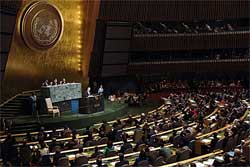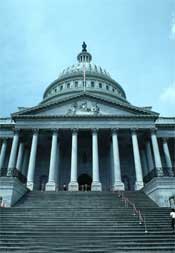 The United States public debt, commonly called the national debt, gross federal debt or U.S. government debt, is the amount of money owed by the United States federal government to creditors who hold U.S. Debt Instruments. As of the end of 2006, the total U.S. public debt was $4.9 trillion. This does not include the money owed by states, corporations, or individuals, nor does it include the money owed to Social Security beneficiaries in the future. If intragovernment debt obligations are included, the debt figure rises to $8.7 trillion. If unfunded future obligations are added (i.e. Medicare and Social Security) this figure rises dramatically to a total of $59.1 Trillion. In 2005 the public debt was 64.7% of GDP. According to the CIA's World Factbook, this meant that the U.S. public debt was the 35th largest in the world by percentage of GDP. The United States public debt, commonly called the national debt, gross federal debt or U.S. government debt, is the amount of money owed by the United States federal government to creditors who hold U.S. Debt Instruments. As of the end of 2006, the total U.S. public debt was $4.9 trillion. This does not include the money owed by states, corporations, or individuals, nor does it include the money owed to Social Security beneficiaries in the future. If intragovernment debt obligations are included, the debt figure rises to $8.7 trillion. If unfunded future obligations are added (i.e. Medicare and Social Security) this figure rises dramatically to a total of $59.1 Trillion. In 2005 the public debt was 64.7% of GDP. According to the CIA's World Factbook, this meant that the U.S. public debt was the 35th largest in the world by percentage of GDP.

 It is important to differentiate between public debt and external debt. The former is the amount owed by the government to its creditors, whether they are nationals or foreigners. The latter is the debt of all sectors of the economy (public and private), owed to foreigners. In the U.S., foreign ownership of the public debt is a significant part of the nation's external debt. The Bureau of the Public Debt, a division of the United States Treasury Department, calculates the amount of money owed by the national government on a daily basis. It is important to differentiate between public debt and external debt. The former is the amount owed by the government to its creditors, whether they are nationals or foreigners. The latter is the debt of all sectors of the economy (public and private), owed to foreigners. In the U.S., foreign ownership of the public debt is a significant part of the nation's external debt. The Bureau of the Public Debt, a division of the United States Treasury Department, calculates the amount of money owed by the national government on a daily basis.
It is common for individual Americans and businesses to buy bonds and other securities, though much of the debt is now held overseas. At the end of 2006, foreign holdings of Treasury debt were $2.223 trillion, which was 44% of the total debt held by the public. Foreign central banks owned 64% of the Federal debt held by foreign residents; private investors owned nearly all the rest.
The country holding by far the most U.S. debt is Japan which held $612.3 billion at the end of the first quarter of 2007. The People's Republic of China has been increasing its holdings of US debt instruments, end the first quarter of 2007 with over $1.2 trillion in total foreign reserves, of which about $420.2 billion are U.S. Treasury securities.

The United States has had public debt since its inception. Debts incurred during the American Revolutionary War and under the Articles of Confederation led to the first yearly reported value of $75,463,476.52 on January 1, 1791. Over the following 45 years, the debt grew, briefly contracted to zero on January 8, 1835 under President Andrew Jackson but then quickly grew into the millions again.
The first dramatic growth spurt of the debt occurred because of the Civil War. The debt was just $65 million dollars in 1860, but passed $1 billion in 1863 and had reached $2.7 billion following the war. The debt slowly fluctuated for the rest of the century, finally growing steadily in the 1910s and early 1920s to roughly $22 billion as the country paid for involvement in World War I.
 The buildup and involvement in World War II brought the debt up another order of magnitude from $51 billion in 1940 to $260 billion following the war. After this period, the debt's growth closely matched the rate of inflation until the 1980s, when it again began to skyrocket. Between 1980 and 1990, the debt more than tripled. By the end of 2005, the gross debt reached $7.9 trillion, about 8.7 times its 1980 level. The buildup and involvement in World War II brought the debt up another order of magnitude from $51 billion in 1940 to $260 billion following the war. After this period, the debt's growth closely matched the rate of inflation until the 1980s, when it again began to skyrocket. Between 1980 and 1990, the debt more than tripled. By the end of 2005, the gross debt reached $7.9 trillion, about 8.7 times its 1980 level.
At any given time (at least in recent decades), there is a debt ceiling in effect. If the debt grows to this ceiling level, many branches of government are shut down or only provide extremely limited service. However, the ceiling is routinely raised by passage of new laws by the United States Congress every year or so. The most recent example of this occurred in March of 2006, when the U.S. Congress agreed to raise the National Debt Ceiling to just under $9 trillion.
Viewed alternately as a percentage of the GDP, the national debt rose sharply during World War II, reaching about 122% of GDP in 1946. As soon as the conflict ended, the debt began declining, reaching a postwar low of 32.6% of GDP in 1981. The debt then started rising again and peaked at 67.3% of GDP in 1996. It then dropped to 57.4% of GDP by 2001 but then began rising again, reaching 64.3% of GDP by 2005. It should be noted that the debt of United States is on par with the debt of other developed countries, such as Germany and France.


International trade involves the exchange of goods and services across national borders. Historically the currencies of nations involved were backed by precious metals (typically using some form of Gold Standard), which would cause a nation operating under a trade imbalance to send precious metals (economic goods in and of themselves) to correct any trade imbalances. In the current scheme of fiat money, the U.S. Government is free to print all the money it wants. Consequentially, the government can not technically go bankrupt and any debtor nation can just issue more money.
 However, if there is a gross imbalance between the amount of money in circulation and the amount of economic goods that are represented by an economy, then there is an unstable situation that can lead to hyperinflation. This has been observed in smaller nations; the modern financial system overseen by International Monetary Fund and World Bank, tend to enforce measures that resemble the Chapter 11 bankruptcy proceedings of an ill-faring private company- with the nation in default makes periodic repayments. However, if there is a gross imbalance between the amount of money in circulation and the amount of economic goods that are represented by an economy, then there is an unstable situation that can lead to hyperinflation. This has been observed in smaller nations; the modern financial system overseen by International Monetary Fund and World Bank, tend to enforce measures that resemble the Chapter 11 bankruptcy proceedings of an ill-faring private company- with the nation in default makes periodic repayments.
The U.S. issues government bonds. The bonds are then bought by investors. The interest rate offered is the one that clears the market. On December 13 2006, the U.S. 30 year treasury note had a rate of 5.375%. Were investors to become concerned about the future value of the US Dollar, they would demand a higher interest rate on US bonds to compensate them for the risk they are assuming.

A traditional defense of the national debt is that we "owe the debt to ourselves", but this is increasingly not true. U.S. Treasury statistics indicate that, at the end of 2004, foreigners held 44% of federal debt held by the public. About 64% of that 44% was held by the central banks of other countries. A large portion was held by the central banks of Japan and China, although most was held by members of the EU. This exposes the United States to potential financial or political risk that either banks will stop buying Treasury securities or start selling them heavily. In fact, the debt held by Japan reached a maximum in August of 2004 and has fallen nearly 3% since then.
Last year, the central banks of Italy, Russia, Sweden, and the United Arab Emirates had announced similar shifts out of the dollar and into other currencies or gold citing the United States' "twin deficits" as the reason for the expected fall in the dollar's value. |